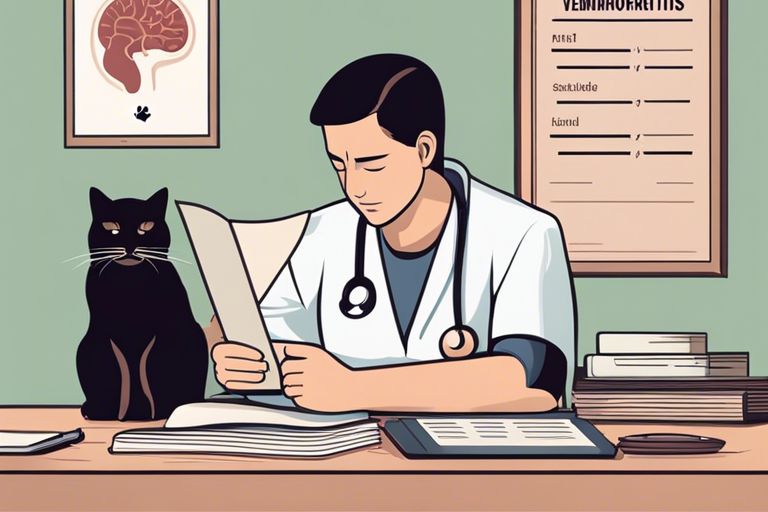Recognizing the signs of pancreatitis in your cat is crucial for their health and well-being. Pancreatitis occurs when the pancreas becomes inflamed, leading to a range of symptoms that can be alarming if left untreated. You may notice that your cat is experiencing abdominal pain, lack of appetite, vomiting, and diarrhea. Additionally, your cat may exhibit decreased energy levels and become dehydrated. It’s important to seek immediate veterinary care if you suspect that your cat may be suffering from pancreatitis, as untreated cases can lead to severe complications. Keep a close eye on your feline friend and seek prompt medical attention if you notice any concerning symptoms.
Key Takeaways:
- Loss of Appetite: Cats with pancreatitis often show a decreased interest in food and may even refuse to eat altogether.
- Abdominal Pain: Look for signs of discomfort such as hunching over, whimpering, or reluctance to be touched in the abdominal area.
- Vomiting: Frequent bouts of vomiting, especially if it contains bile or appears to be painful for the cat, could be a sign of pancreatitis.
- Dehydration: Excessive drinking, urinating, or lethargy can indicate dehydration, which can result from pancreatitis.
- Weight Loss: Unexplained weight loss in your cat, especially when paired with other symptoms, may be a sign of pancreatic issues.

Understanding Pancreatitis
One of the important aspects of taking care of your feline friend is recognizing the signs and symptoms of pancreatitis. This condition can be quite serious and potentially life-threatening, so it’s crucial to be well-informed about what to look out for and how to take appropriate action.
Definition and Types
Pancreatitis in cats is a condition characterized by inflammation of the pancreas, which is a vital organ responsible for producing digestive enzymes and insulin. There are two main types of pancreatitis in cats: acute and chronic. Acute pancreatitis is a sudden and severe form of the condition, while chronic pancreatitis is an ongoing, long-term inflammation of the pancreas.
- Acute pancreatitis can be triggered by factors such as high-fat diets, certain medications, or trauma to the abdomen.
- Chronic pancreatitis may develop over time and is often associated with other feline health issues, such as inflammatory bowel disease.
The sooner you can recognize the signs of pancreatitis in your cat, the better chance you have of getting them the necessary treatment.
Causes and Risk Factors
Pancreatitis in cats can have a variety of causes and risk factors. It can be associated with certain infections, such as feline infectious peritonitis (FIP), as well as other health conditions like diabetes mellitus. Additionally, obesity and high-fat diets can increase the risk of developing pancreatitis in cats. Recognizing these potential causes and risk factors can help you take proactive steps to keep your cat healthy and minimize their chances of developing pancreatitis.
Signs of Pancreatitis in Cats
Some cats may develop pancreatitis, a condition characterized by inflammation of the pancreas. Recognizing the signs of pancreatitis in your cat is crucial for seeking timely veterinary care and ensuring the best outcome for your feline companion.
Behavioral Changes
If your cat is suffering from pancreatitis, you may notice changes in their behavior. They may become unusually lethargic, withdrawn, or seek out hiding spots more frequently. You may also observe a decrease in their appetite and overall interest in activities they previously enjoyed.
Gastrointestinal Symptoms
In addition to behavioral changes, gastrointestinal symptoms are common in cats with pancreatitis. You may notice vomiting, diarrhea, or a reluctance to eat. Your cat may also display signs of abdominal discomfort, such as hunching over or vocalizing when their abdomen is touched.
Physical and Clinical Signs
Physical and clinical signs of pancreatitis in cats can include weight loss, jaundice, and dehydration. Your cat may also exhibit a hunched posture, have a tender abdomen, or show signs of fever. It’s important to be attentive to these physical and clinical signs and seek prompt veterinary attention if you notice any of them in your cat.
Complications and Concurrent Diseases
Cats with pancreatitis may be at risk of developing complications such as diabetes mellitus or hepatic lipidosis, especially if the condition is left untreated. Concurrent diseases, such as inflammatory bowel disease, may also be present in cats with pancreatitis. Monitoring and managing these complications is essential for your cat’s overall health and wellbeing.
Diagnosis and Treatment
Despite the signs and symptoms you’ve observed, diagnosing pancreatitis in your cat can be challenging. Your vet will likely start with a physical examination, blood tests, and a thorough medical history to rule out other potential causes. In some cases, imaging such as an ultrasound or MRI may be required to get a clearer picture. For more details on diagnosing and treating pancreatitis in cats, you can visit My cat has pancreatitis.
Diagnostic Procedures
If your vet suspects pancreatitis, they may recommend a series of diagnostic procedures to confirm the diagnosis. Blood tests can help assess your cat’s overall health and check for elevated pancreatic enzymes, while imaging studies such as ultrasound or MRI may be necessary to visualize the pancreas and surrounding tissues. In some cases, a biopsy of the pancreas may be recommended for further evaluation.
Treatment Options and Management
Once pancreatitis has been diagnosed, your vet will outline a treatment plan tailored to your cat’s specific needs. This may include hospitalization for more severe cases, where your cat can receive supportive care such as intravenous fluids, pain management, and nutritional support. Depending on the severity of the condition, your vet may also prescribe medication and recommend dietary modifications to manage your cat’s pancreatitis. In some cases, long-term management and monitoring may be necessary to ensure your cat’s ongoing health and well-being.
Prevention and Care
For both the prevention and care of pancreatitis in your cat, it is important to pay attention to their diet and nutrition, as well as regular health check-ups and monitoring.
Dietary Considerations and Nutrition
When it comes to preventing pancreatitis or caring for a cat with pancreatitis, diet plays a crucial role. It is important to feed your cat a high-quality, balanced diet that is low in fat. Avoid feeding them table scraps or high-fat foods, as this can trigger an episode of pancreatitis. Some cats may also benefit from a prescription low-fat diet specifically designed for pancreatitis. Be sure to consult with your veterinarian to determine the best diet for your cat’s specific needs.
Regular Health Check-Ups and Monitoring
Regular health check-ups are important for the early detection and monitoring of pancreatitis in your cat. Your veterinarian can perform physical exams, blood tests, and imaging to monitor your cat’s pancreas health. This is especially important if your cat has a history of pancreatitis or is at a higher risk of developing the condition. Keeping a close eye on your cat’s eating habits, behavior, and overall well-being can also help you catch any potential signs of pancreatitis early on, allowing for prompt medical intervention.
Conclusion
Hence, it is important to be aware of the signs of pancreatitis in cats, so you can seek prompt veterinary care for your feline companion. Remember to monitor your cat for symptoms such as vomiting, diarrhea, abdominal pain, and decreased appetite, as these could be indicative of a possible pancreatitis. If you notice any of these signs, it is crucial to consult with your veterinarian to ensure the best possible outcome for your cat’s health.
FAQ
Q: What are the signs of pancreatitis in cats?
A: The signs of pancreatitis in cats can vary, but common symptoms include vomiting, diarrhea, lack of appetite, abdominal pain, dehydration, and lethargy. In severe cases, jaundice and difficulty breathing may also be present.
Q: How is pancreatitis diagnosed in cats?
A: Pancreatitis in cats is typically diagnosed through a combination of physical examination, blood tests to assess pancreatic enzymes, imaging tests such as ultrasound or X-rays, and sometimes a biopsy of the pancreas or surrounding tissues.
Q: What treatment options are available for pancreatitis in cats?
A: Treatment for pancreatitis in cats often involves hospitalization, fluid therapy to address dehydration, pain management, and a carefully monitored diet. In severe cases, supportive care such as feeding tubes or medication to control vomiting may be necessary. It’s crucial to work closely with a veterinarian to develop an individualized treatment plan for each cat.

Jayley, a devoted cat enthusiast, also writer for other cat blog as well. She aims to dedicated to providing comprehensive information, insights, and advice on everything you’d ever want to know about our whiskered companions.
